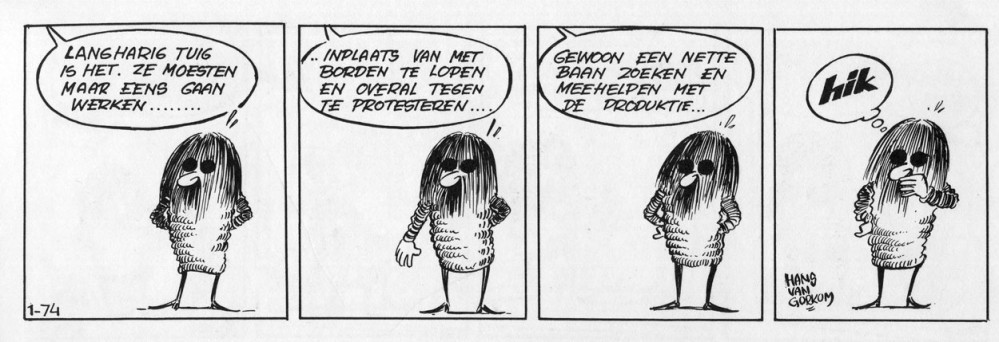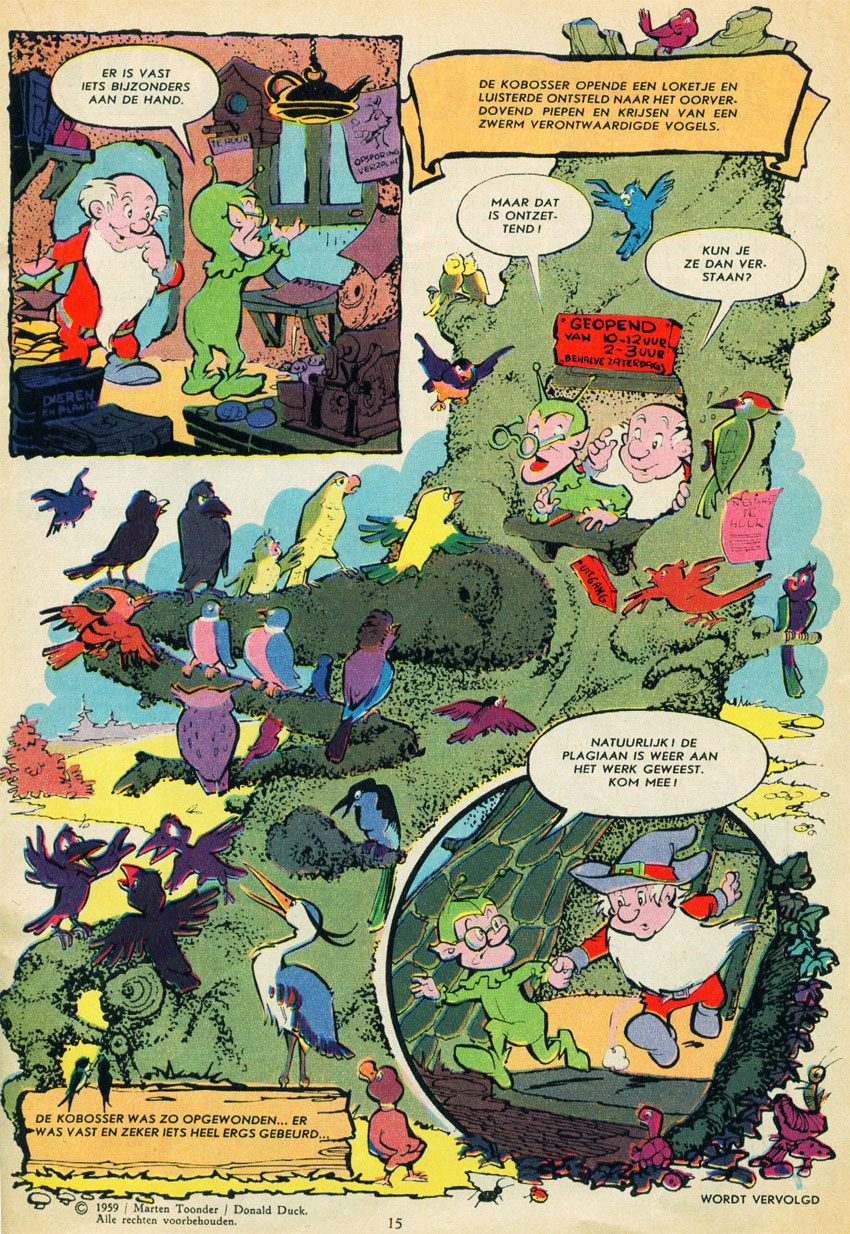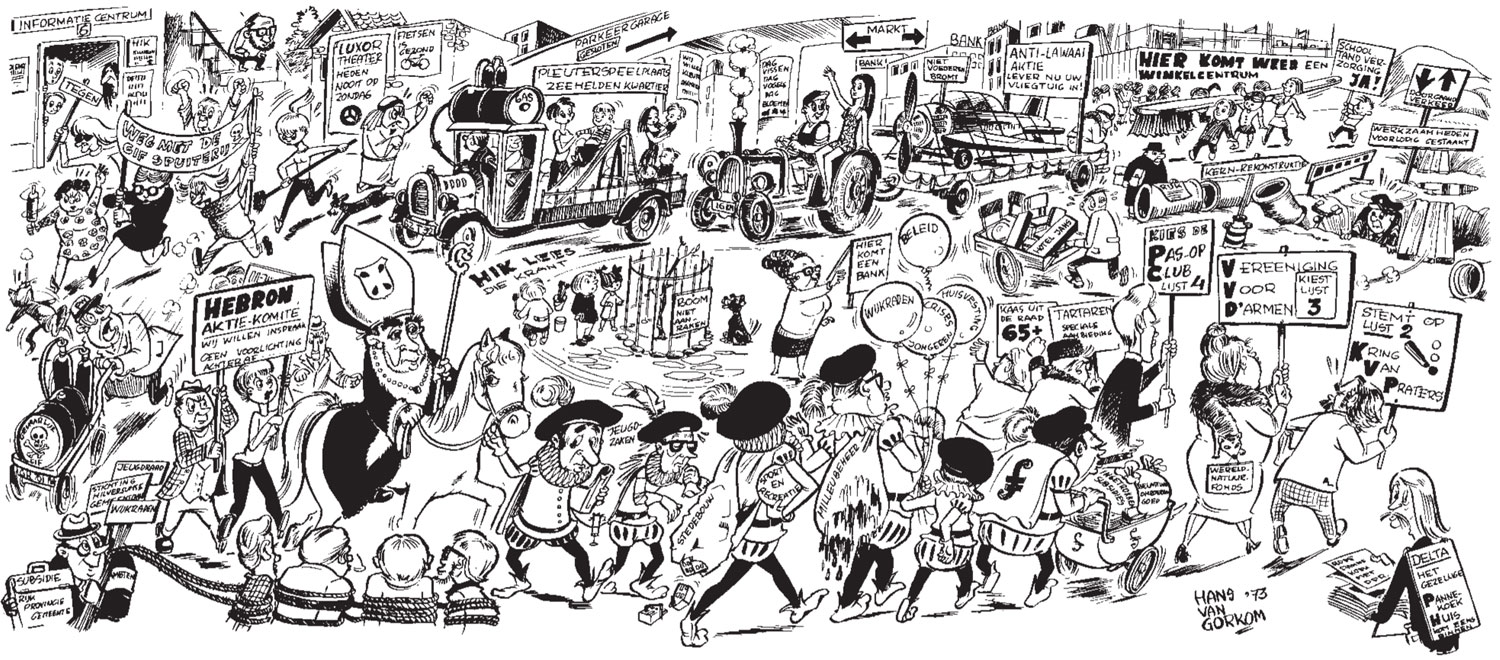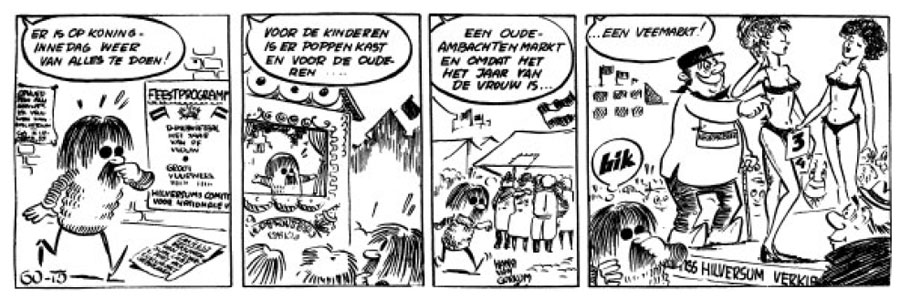8 January 1974 'Hikkie' strip.
Dutch artist and social worker Hans van Gorkom began his career with the Toonder Studio's, drawing for ongoing comic productions like 'Olle Kapoen'. Between 1973 and 1981, he was the regular illustrator for the local Hilversum information and communication paper HIK, drawing the satirical comic feature 'Hikkie'.
Early life
Hans van Gorkom was born in 1929 in Maastricht, capital of the southern province of Limburg. One year later, however, the family moved to Hilversum, where Van Gorkom continued to live for the rest of his life. His father was an electrical engineer, and the family ran the vacuum cleaner sales and repair shop De Stofzuiger-centrale at the Groest in Hilversum (which, as of 2024, is still managed by a Van Gorkom). Hans van Gorkom's secondary education was cut short due to the outbreak of World War II, but he did have two years of private drawing lessons from a local art teacher.
'Olle Kapoen en de Plagiaan' (Donald Duck #27, 1959).
Toonder Studio's
In 1947, Hans van Gorkom found employment as an inker with the Toonder Studio's, at the time the largest production house of comics and animation in the Netherlands. Part of his workload was doing artwork for advertisements and assisting on several of the studio's newspaper comics, such as 'Panda' and 'Tom Poes'. In 1956, he briefly penciled the 'Tom Poes' newspaper comic as a holiday replacement for Ben van 't Klooster.
Starting in the early 1950s, Van Gorkom was part of the artists team working on the newspaper text comic about the gnome 'Olle Kapoen', written by Marten Toonder's wife Phiny Dick. At the end of the decade, he worked with writer Andries Brandt on a couple of 'Olle Kapoen' balloon comic stories for the Dutch Disney weekly Donald Duck. This included reworkings of older newspaper episodes in a magazine format, but also a new story, 'Olle Kapoen en de Plagiaan' (1959). For their stories, Brandt and Van Gorkom chose a more experimental graphical approach to their panel layout. However, the comic didn't catch on with Donald Duck's readership, and the feature lasted only a year.
Drawing for the 6 December 1973 issue of HIK, showing the social issues in Hilversum that season.
Youth worker
Dealing with kidney problems since his childhood, Hans van Gorkom left the Toonder Studio's in 1961 after a disagreement over his health insurance. He then spent a couple of years working in his father's company, before he became a civil servant with Hilversum's municipal department for sports and youth affairs. His main tasks were supervising the municipality's youth council and youth holiday work services. In his approach, Van Gorkom was a maverick, who often instigated the youth to speak out and stand up for their interests. In 1972, Van Gorkom received his degree as cultural worker. In his final thesis, he critically reflected on the municipality's youth policies and cultural work, and concluded that his own function was superfluous. In the following year, he was let go.
Hikkie
Despite his discharge and his ongoing health issues, Van Gorkom remained involved in Hilversum's social and cultural work through associations with the local youth holiday work program, the scouts and Unicef. Between 1973 and 1981, he was the illustrator and cartoonist of HIK (Hilversumse Informatie en Kommunikatie), an independent weekly, appearing on two pages in the local newspaper Gooi- en Eembode. While the supplement was initially launched as a way for the municipality to communicate more directly with civilians, HIK also invited readers to send in their own articles and comment on social issues.
17 April 1975 'Hikkie' strip, addressing the irony of celebrating International Women's Year with a miss contest (called a livestock market in the final panel).
Besides countless illustrations and satirical cartoons, Van Gorkom also created the four-panel comic strip 'Hikkie', featuring a character with long hair, sunglasses and a baggy sweater. His name 'Hikkie' is a pun on the word "hippie", the Dutch word "hik" (="hiccup") and the magazine in which the gags appeared (HIK). A symbol of the protest generation, Hikkie is constantly criticized by offscreen characters for his looks, actions and mindset, but he is also an observer of social inequalities, hypocrisy and political failures. In the final panel, he replies with a single hiccup, which sometimes serves as a punchline. After a two-year gap during which HIK didn't appear (1975-1977), Hikkie returned in a more active role, and with more decent looks. In the new episodes, he headed out to address social injustices in the town of Hilversum. In many ways, Hikkie was an alter ego for his creator Hans van Gorkom, who was a critical and colorful civilian with an ironic sense of humor. Believed that citizens should play a more vocal role in democracy, he focused on topics that he felt were not being handled correctly by politicians. A landscape-format comic booklet collecting the early 'Hikkie' strips was released in 1975.
Final years and death
The final 'Hikkie' strip appeared in the 13 March 1981 issue of H.I.K. magazine. After that, the paper only featured reprints of older strips, as well as an occasional new spot illustration by Hans van Gorkom. After a long illness, Hans van Gorkom died in his hometown Hilversum on 8 September 1987, at the age of 58.
Hans van Gorkom was disappointed that he wasn't included in Evelien and Kees Kousemaker's 1979 encyclopedia 'Wordt Vervolgd' (but he is on this website). Photo: Loek van Gorkom.







